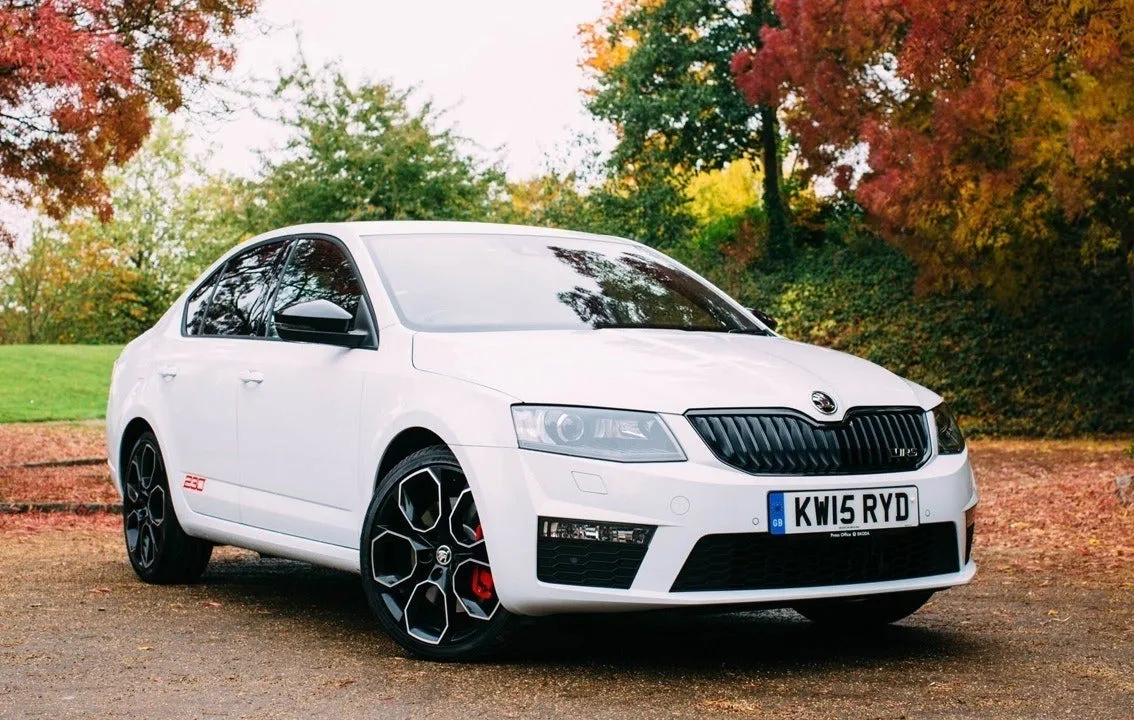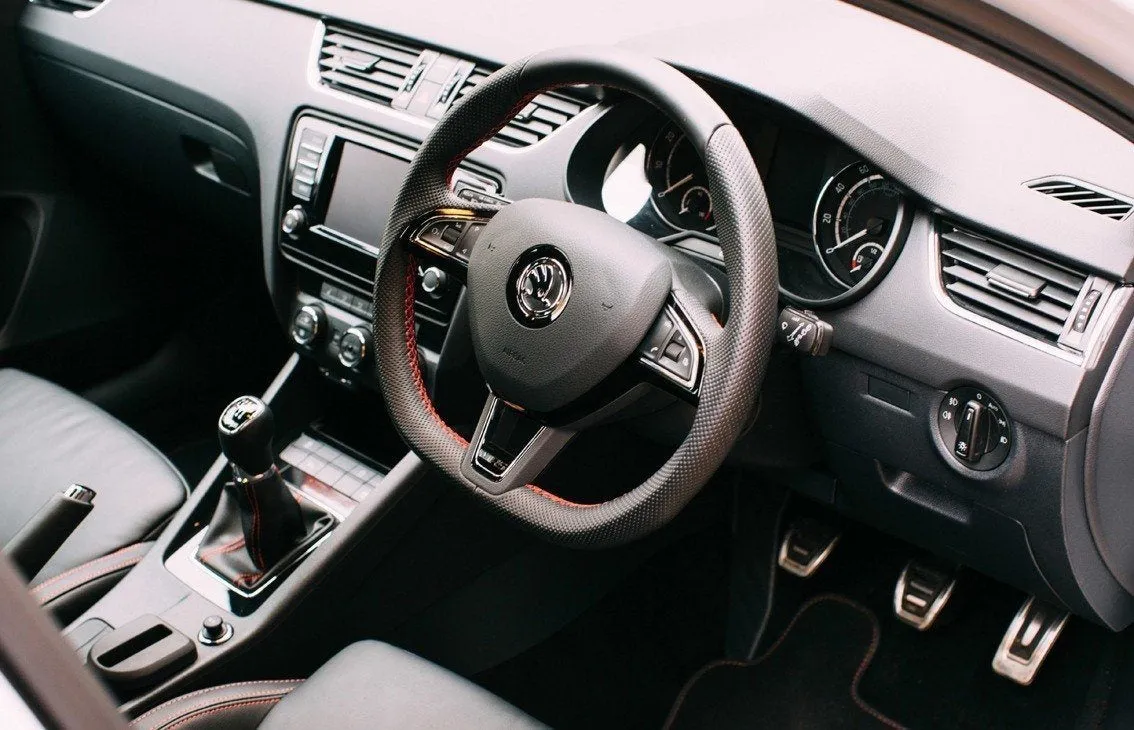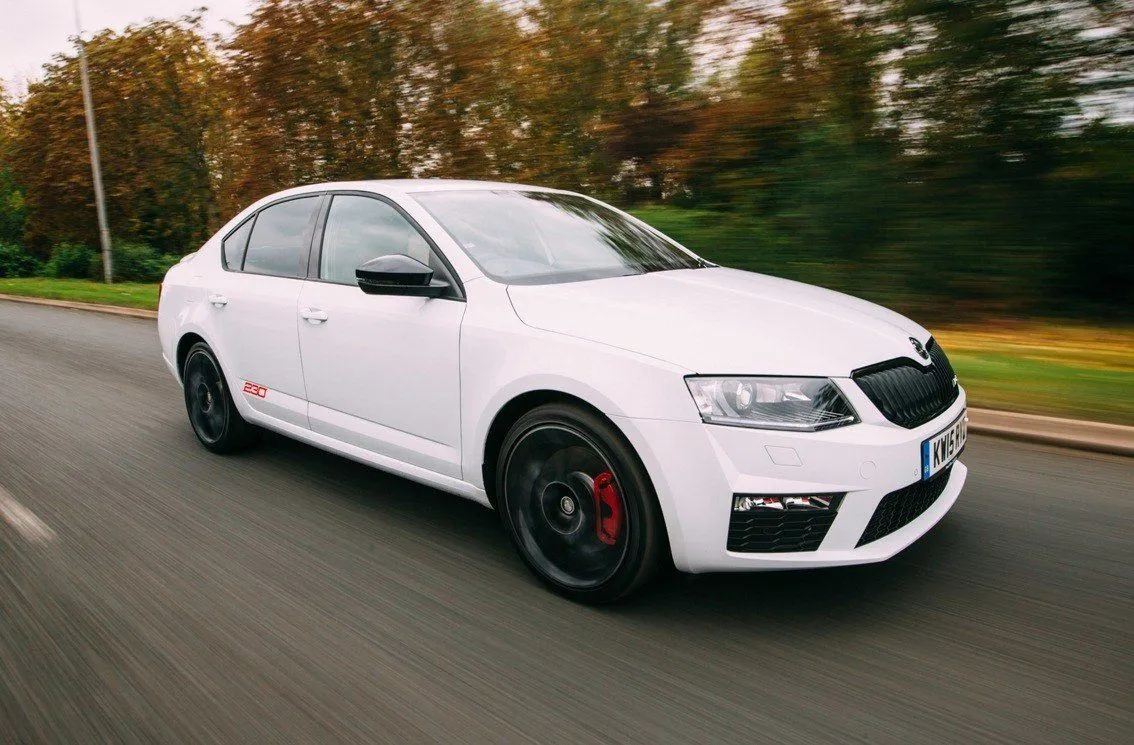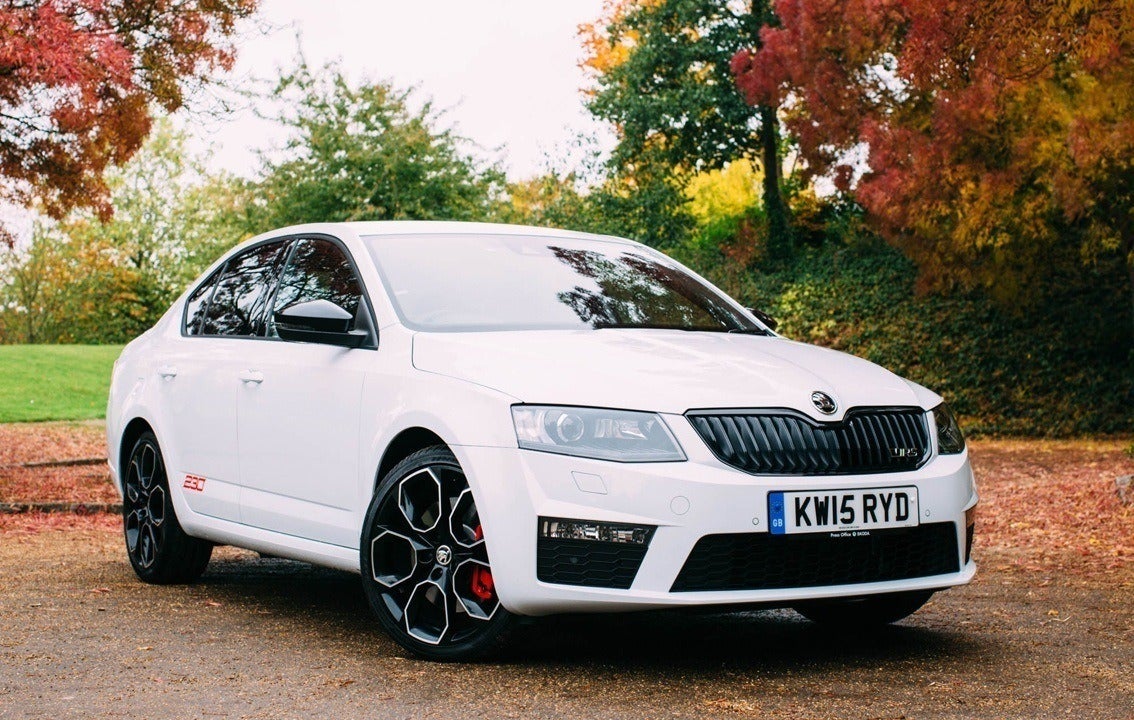Skoda Octavia vRS (2013-2020) Review
Written by Andrew Brady
Quick overview
Pros
- Massive boot in either the hatch or estate
- Good level of standard equipment
- Sensible pricing, discreet looks, fine cabin
Cons
- It’s good to drive rather than exceptional
- Skoda badge still misunderstood by some – even if they’re wrong
- New version is more of the same, but better
Overall verdict on the Skoda Octavia vRS
"In this Skoda Octavia vRS review we are looking at a sensible take on the hot hatch segment. As you might expect from a Skoda, the Octavia vRS is quick and capable, but discreet with it. It's also just as practical as the regular car, which means it will fit into your life equally as well. What it lacks is the last degree of excitement you get from some rivals, but that doesn't make it a bad choice - particularly when buying used."

“Just buy a Skoda Octavia.” That’s pretty much the stock response when car people are asked by non-car-loving friends what they should buy as family transport.
That, or a Golf, of course, but as the Skoda’s spun from the same underpinnings as its Volkswagen cousin, yet manages to liberate masses more space from them, it’s the Skoda Octavia that wins out. A pragmatic choice then, and for those car-loving people dishing out the advice, there’s even a model for them.
The Skoda Octavia vRS retains all the sensibleness of the brand's more bread-and-butter offerings - the Skoda Octavia hatch and Octavia Estate - but adds another slice and a packet of salt and vinegar crisps for a naughtier offering with a bit more bite. Like those regular Octavias, the vRS is offered in massive hatchback guise or even more gargantuan estate, in relation to load-swallowing ability as opposed to its physical size on the road.
The vRS badge is to the Octavia what GTI is to that Golf, it has been around long enough to be familiar, at least among the car informed among you. It’s long stood for quick but discreet transport that comes with few compromises for the added pace it brings. That’s remained true right through to this third version of the Octavia, which was introduced in standard guise way back in 2012, with the vRS unveiled a year later in 2013.
Obviously, it’s been refreshed in the years since, with the 220PS offering of the original upped to 230PS fairly quickly, while in 2015 Skoda also added a 245PS model into the mix, it denoted by a little black v on its vRS badge rather than the green of the lesser-powered version.
There’s also 2.0-litre TDI for those wanting their Skoda Octavia vRS with a leggier range and more palatable CO2 emissions for their company car tax bill. 2018 saw the Octavia gain a new look, grafting, not entirely successfully we might add, a new look onto the front of the big hatchback and estate.
That takes the vRS up to early 2020, where the entire Octavia line-up is slowly winding down to make way for an all-new - but doing everything the same because why fix something that isn’t broken – Octavia, which will see the vRS badge top the line-up again. That new vRS will adopt plug-in power, mating a 150PS TSI turbo petrol engine to an electric motor, the combined output of which will match the 245PS of this outgoing vRS.
It’s no surprise that Skoda is future-proofing its vRS with the new model, as despite it being at the top of the range, it’s a good seller, in its core UK and German market the vRS apparently accounting for one in every five Octavia sales. We’ll see that soon, but if you want one of the outgoing one you’ll need to be quick, or go the used route.
Looking for a used car for sale? We've got 100s of Skoda Approved Used Cars for Sale for you to choose from, including a wide range of Skoda Octavia vRS cars for sale. If you're looking for the newer version, you need our Skoda Octavia vRS review.
Is the Skoda Octavia vRS right for you?
We’ve about 150 words of reasoning to fill here why and how a Skoda Octavia vRS might be right for you, but, put simply, yes. Yes. Yes, x147 etc. a Skoda Octavia vRS is right for you. Indeed, short of needing more than the five seats (four comfortably) that it offers, we can’t genuinely think of any reason why the Skoda Octavia vRS wouldn’t work for you.
If it’s the badge, get over it, Skoda’s the thinking person’s Volkswagen or Audi, and cool because of that. If it’s still an issue, go buy a Golf GTI, and wonder how your friend with their vRS always manages to easily pack for a two week holiday while you struggle to manage luggage for a one week one. Boot space isn’t the only reason you’ll want a Skoda Octavia vRS, even if it’s a compelling one, it’s actually the roundedness of the entire package, which despite being the sporting flagship isn’t overt in its looks or compromised in its suspension, while the cabin is both spacious and feels of high quality, too.
What’s the best Skoda Octavia vRS model/engine to choose?
Which vRS depends entirely on your sensibilities and use. You don’t need the estate, really, as the hatchback is so vast it’s got boot space that’ll be enough for most of you, that said, the estate, to our eyes, is the better looker of the pair. Likewise the engine choices, the 230PS model will be absolutely fine, but the 245PS adds a bit more pace and equipment.
Big miles? Then that diesel is worth a look, too, it slower on paper, but the low-rev flexibility makes it feel as quick on the road as the more demanding rev-hungry petrols.
The diesel is also offered in four-wheel drive, which if you’re towing is useful. All are commendable, and only you know how you’ll use it, but we’d be perfectly happy with a 230PS estate with a manual transmission. Good luck finding a new one though, with Skoda Octavia vRS now set to be replaced the run-out stock of them all seems to be the 245 DSG 7-speed automatic.
What other cars are similar to the Skoda Octavia vRS?
The Octavia’s space puts it in the category above that which it’s priced in, so you get a lot for your money. It’s priced to compete with Volkswagen Golf-sized rivals, with its most obvious competition coming from the same Volkswagen parent group and including things like the SEAT Leon Cupra in both hatchback and estate forms, as well as the Golf GTI.
Widening that further, you could go for something like a Ford Focus ST hatch or estate and a host of other warmed-over and hot hatchbacks and estate cars. A lot of these, like the Octavia vRS itself, are nearing the end of their current production life-cycle, and are due to be replaced soon.
Comfort and design: Skoda Octavia vRS interior
"With its more sporting intent than the rest of the Skoda Octavia range, the vRS models gain front seats with deeper bolstering, these sports style seats not just helping hold you in tightly if you’re enjoying the performance on offer, but also providing fine all-round support, that translating to excellent comfort on longer drives."

With the Challenge trim, introduced in 2019, those seats are electrically adjusted and feature a memory package to store the preferred seating position for a number of drivers.
The design of the cabin is, as you might expect from Skoda, uncomplicated in its style. Fundamentally – save the addition of ever bigger, screens for the infotainment and instrumentation – it’s remained unchanged since the Octavia’s 2013 introduction, that underlining the longevity of the Skoda’s unfussy interior look.
That clarity and unfussiness does mean it all works well, it easy to get a decent driving position, and the view out is good all-round, the view out the rear better in the estate than the hatchback. There’s standard climate control with the vRS, electrically adjustable, heated rear view mirrors, parking sensors and cruise control as standard, too.
Quality and finish
Skoda has traditionally been associated with good value, that's apparant not just in the space the Octavia offers for the money you’ll pay for it, but also the quality of the interior.
The materials are of a quality that you’d be happy to have in a more expensive Volkswagen, which puts the Skoda Octavia vRS’s interior right up with the best of its mainstream rivals in terms of quality look and feel. The plastics on all the touch points are generally soft to touch, with only a little evidence of some cost-cutting with materials in areas you’ll rarely see and are even less likely to feel, and that’s true of a lot of the Octavia’s competition.
With the Skoda Octavia vRS the overall interior is lifted with its status as the sporting flagship, so along with the more body-hugging sports seats, which, in the Challenge at least, has Alcantara covering them. There’s a perforated leather-covered steering wheel with contrasting stitching, the vRS not only living up to its sporting flagship billing but feeling very well built, too.
Infotainment: Touchscreen, USB, nav and stereo in the Skoda Octavia vRS
The Skoda Octavia vRS features the Amundsen touchscreen sat-nav system as standard, it featuring an 8-inch touch screen with touch shortcut buttons surrounding it to access the most commonly used functions. There’s standard DAB and Bluetooth connectivity, aux in and USB sockets, with smartphone mirroring, Android Auto and Apple CarPlay. It’s quick and easy to operate, with a crisp screen, it, like the rest of the vRS unambiguous in its operation, and looking neat in the top of the central dashboard.
There are physical knobs for things like the volume and screen zooming on the navigation, likewise, the Skoda Octavia vRS’s age means the ventilation and heating controls remain independent from the screen, these too having physical, simple to locate and use on the move, rotary knobs and buttons – and is all the better for it than some newer rival’s overly complicated screen and menu requirements.
There’s the option of a digital dashboard, which offers some configurability, but it lacks the slick look and operation of the best of its rivals’ systems, and the Skoda Octavia vRS’s simplicity elsewhere better suits the standard, crisp analogue dials that come as standard.
Space and practicality: Skoda Octavia vRS boot space
The Skoda Octavia has always been a load-lugging champion and popping a hotter engine under the bonnet and changing the suspension to suit it does absolutely nothing to alter that. The boot in the hatchback is vast, offering a volume of 590 litres with the rear seats in position, and 1,580 litres with them folded – these doing so in a 60/40 split and released by handles in the boot.
For comparison, a Golf’s volumes are 380 litres and 1,270 litres respectively. Indeed, the Skoda Octavia vRS’s hatchback boot is bigger, with the seats up, than a Ford Focus Estate, and only 40 litres shy of its maximum capacity with the seats folded. Voluminous, then, but for some big is never enough, and the estate is there for them.
Seats in position there’s 610 litres and 1,740 litres with the seats folded, not exactly huge gains with the rear seats in place, but if you’re putting the mutt back there it’ll thank you for the additional headroom and is less likely smear the Skoda Octavia vRS’s rear window with its wet nose.
The estate also gets the option of a double-height floor – basically a panel – that gives some underfloor storage, but its biggest advantage is that with the seats folded you’re left without a step halfway up the boot. Buying the 4x4 TDI Skoda Octavia vRS doesn’t impact on boot space, either, but it’ll get you further into a field for those more adventures dog walks.
Elsewhere in the Skoda Octavia vRS that feeling of space continues, with good head and legroom in the back, the Octavia still among the very best in the class for rear passenger space. It’ll be a push to carry three adults in the back in comfort, likewise, three abreast child seats will be tricky, with only the outermost seats having ISOFIX child seat mounts anyway, but there isn’t a car in the Octavia vRS’s class that will manage that feat. There’s a couple of door bins in the rear as well as map pockets in the backs of the front seats.
Oddment storage up front is fine, with good-sized door bins and a glovebox, with a pair of cupholders and deep lidded cubby between the front seats, it also having a hand recess in front of the gearstick that’s perfect for chucking your mobile phone and/or wallet into.
Such is Skoda’s obsession with umbrellas there’s a pouch under the front seat which holds a small folding one, while the standard parking ticket clip in the windscreen and ice scraper in the fuel cap cover are nice, eminently Skoda–sensible touches, too.
The Skoda Octavia vRS dimensions are 4685mm long, 2017mm wide and 1449mm tall for the hatchback, and 4685mm long, 2017mm wide and 1452mm tall for the estate.
Handling and ride quality: What is the Skoda Octavia vRS like to drive?
"In keeping with its sensible side the ride and handling errs on the side of caution rather than outright engagement, which, in reality, is a good thing."

There’s balance on offer, with the steering quick-witted and nicely weighted, the Skoda Octavia vRS feeling pleasingly agile, even if it’s not as rapid in seeking out apexes as some of its newer, more focussed competition.
The compromises because of this are fewer though, and in real-world driving, welcome, the vRS mixing fine handling with decent ride comfort, even on some of the larger 19-inch wheel choices. If you’re going to go down the biggest wheel option route it’s worth going for the Dynamic Chassis Control option, which adds variable settings to the dampers, the Comfort mode taking the edge off rougher surfaces yet still maintaining decent control – with the option to tighten things up with more aggressive, less yielding, damper settings.
Key differences among the various models include the Skoda Octavia vRS 245’s standard fitment of an electronically controlled mechanical locking differential, which improves traction and steering response, and for those wanting the assurance of even more traction the TDI vRS comes with four-wheel drive. It feels predominantly front-wheel drive, but if it senses slip on the front wheels then it’ll divert drive to the rear axle.
That’s useful if you’re towing or more rural in your location, or the Labrador has decided it can’t be bothered walking back to the car park and you need to drive through the field to go get it.
All might not offer the pin-sharp agility of the best of the competition then, but the roundedness of its ride and handling is what marks the Skoda Octavia vRS out as good, and, you’ll be thankful of that more often in daily driving than you would tauter control and a fidgety ride that would come to allow the Skoda Octavia vRS to do something as wilfully irrelevant as set a sportscar-bettering Nurburgring lap time.
What engines and gearboxes are available in the Skoda Octavia vRS?
Two engines are offered with the Skoda Octavia vRS, a 2.0-litre turbocharged petrol with either 230PS or 245PS and a 2.0-litre TDI with 184PS.
They’re all good engines, with the revvy 2.0-litre turbocharged petrols with the ability to reach 62mph in a 6.6 seconds for the hatchback and 6.7 seconds for the estate with the 230PS car in manual guise, adding the DSG automatic or upping the power to the 245PS version only adding a tenth or two one side or the other of those figures.
The TDI is a bit slower against the crude measure of the stopwatch, but on the road it doesn’t feel it. Indeed, its lower rev urge makes up for its lack of verve at the top end. That’s the key difference between the characters of the two fuels, the diesel all about more effortless surge, the petrol choices requiring a bit more commitment to keep them in their higher powerband, so it’s down to what kind of driving you do to decide which best suits you.
That’s true of the transmissions too. The six-speed manual is good, with a solid, rather than exceptional shift quality, while the DSG ups the convenience factor while robbing the vRS of some of its outright engagement. We’d typically err towards a manual in our hot hatchback, but such is the sensibilities of the Skoda Octavia vRS as a daily, family driver, then that DSG choice has real merit, and actually helps lower CO2 emissions marginally, too.
Refinement and noise levels
No concerns in relation to refinement and noise levels, the vRS being decently refined for a family car, to the point some more demanding drivers might want some more sounds from it. Wind noise is nicely contained at UK speeds, while road noise too isn’t any worse than its key rivals, with the usual proviso that the bigger the wheels you go for then the greater the intrusion of sounds from the road will be on less than perfect surfaces – like combed concrete on the motorway.
The turbodiesel emits the faint rattle that betrays its requirement for derv, but it’s not so noteworthy to be distracting, likewise it generates a bit more vibration – when re-starting as part of the stop-start system – but, again, it’s not really an issue, particularly on the move.
Safety equipment: How safe is the Skoda Octavia vRS?
Back in 2013 the then-new Octavia achieved a five-star maximum score in the independent Euro NCAP crash testing results, and while the standards for testing have changed slightly, the vRS will still protect you well. Helping avoid an accident in the first place is an alphabet of assist systems with the Electronic Stability Control system working with ABS anti-lock brakes, EBV, MSR, ASR, EDS, HBA, DSR, ESBS, TSA, KKB, XDS and pre-fill brakes that prime the pistons for increased stopping power.
There’s a driver fatigue sensor, driver and front passenger front and side airbags as well as curtain airbags. There’s Lane Assist, the vRS doing without the very latest driver assistance systems, but to many that’s not necessarily a bad thing.
MPG and fuel costs: What does the Skoda Octavia vRS cost to run?
"The diesel is obviously the fuel economy champion, even in final four-wheel drive DSG automatic only form, it's able to return 47.9mpg and emit 156g/km on the WLTP combined consumption test cycle."

The petrols are still commendable in this respect, with mpg around the 37mpg sphere (going up or down marginally depending on spec) likewise CO2 emissions are around 170g/km.
How reliable is a Skoda Octavia vRS?
The Skoda Octavia scored a decent 9.14 out of 10 for reliability, which isn't exceptional as far as Skodas are concerned. One area to look closely at is the DSG gearbox, which has been known to cause problems - ensure any car so equipped has a full dealer service history.
As a brand Skoda finished an impressive 6th overall out of 30 manufacturers, which suggest most owners are very happy with their Skodas.
Insurance groups and costs
Being the fastest model in the range means the vRS attracts the biggest insurance premiums but the 245PS models’ group 29 insurance is no worse than any rivals of similar performance and price. If you want to save a bit on insurance costs the 184 TDI is group 26, and insuring all shouldn’t be a problem, or too costly.
VED car tax: What is the annual road tax on a Skoda Octavia vRS?
How old your Skoda Octavia vRS is plays a big part in what your annual VED bill will be. For cars registered before April 2017, you'll pay £180 a year for the petrol manual and £220 for the Challenge version, while diesels are £30 for the 184PS DSG up to £180 for the earlier version with 170PS.
Post April-2017 cars all attract the same £165 flat rate.
How much should you be paying for a used Skoda Octavia vRS?
"Around £6,000 will get you into an early Skoda Octavia vRS, with plenty available from this price point, and a few possible for less – if you’re happy with intergalactic mileages. "

There’s a sizeable weighting towards estates in the classifieds, which isn’t really surprising, likewise the diesel evidently sold very well, too, these making up the bulk of used vRS Octavias. Around £9,000 seems to be the point where you’ll start to get sub-100,000 mile examples, and from £10,000-£15,000 you can afford to be very picky,
Trim levels and standard equipment
The vRS is a trim level in its own right, with all engines broadly getting the same standard equipment.
vRS – Dual zone climate control air conditioning, sports seats, rear parking sensors, sat-nav, vRS styling inside and out, Driving mode selection, sports steering wheel with multifunction buttons, LED front foglights and alloy wheels.
Ask the heycar experts: common questions
Is the Skoda Octavia vRS a good car?
Is the Skoda Octavia faster than a Lamborghini?
Is the Skoda Octavia vRS a 4x4?
Get our latest advice, news and offers
Keep me updated by email with the latest advice, news and offers from heycar.
By submitting you agree to our privacy policy



